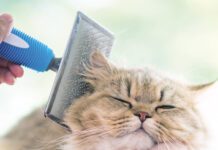Dear Elizabeth: I found a whisker on the floor near my cats food bowl. Is this a problem? Will Mr. Bee grow a replacement whisker or is it gone forever? I have had whiskers all my life, but I really took them for granted until recently. Whiskers just seemed like big, fat hairs to me! So what are they, exactly? Well, all of a cats fur grows from hair follicles in the epidermal layer of the skin. Whiskers are specially modified (big, fat) hairs that grow from very large follicles in specific locations. Of course, the most prominent whiskers are those that grow on the upper lips of the muzzle. These are so lovely and are so much a part of being a cat that I was surprised to learn they are not unique to felines. In fact, mammals from mice to walruses have muzzle whiskers. Though they are nowhere near as attractive as ours, even dogs have whiskers! 288 Whoever they are growing on, whiskers on the upper lip are given the special name of “mystacial.” Cats generally have about 24 mystacial whiskers. If you admire your cat closely, youll notice that mystacial whiskers are arranged in neat, horizontal rows on either side of the nose. Not only that, but whiskers grow on other parts of the body, too. Genal whiskers grow as solitary whiskers on the cheeks. Superciliary whiskers grow above the eyes. Finally, cats often have “wrist whiskers” growing from the rear of the carpal area (wrist) of the forelimbs. Mystacial whisker follicles are surrounded by a rich supply of nerves and muscle fibers. This arrangement allows us cats to use our whiskers for communication; we can rotate them forward to show increasing levels of interest, irritation or aggression and pull them close to the face when were afraid. We also use whiskers as extensions for our sense of touch. Since whisker length is correlated to head and body width, scientists think that we use tactile input from whisker movement to help judge our “fit” into the environment. This is particularly useful during nighttime hunting forays into the woods (or pantry), when we cant see much. Wrist whiskers are thought to provide tactile information when were climbing and hunting. Hair growth goes through a cycle based on changes that take place in the follicle. Follicles actively produce hair shafts during whats called the anagen phase. The machinery of hair shaft production then shuts down during a brief catagen phase, after which the hair follicle enters its rest, or telogen, phase. During the telogen phase the hair is no longer growing, but is simply anchored within the inactive follicle. As the follicle enters its next anagen phase, the old hair shaft falls out and a new shaft grows. Scientists arent certain what determines the duration of a given follicles cycle. As in so many biological systems, many factors are thought to be involved, with a genetic program setting a normal range and external factors, such as daily light exposure, hormone level and nutrition, exerting influence within that range. Whisker follicles go through the same cycle of growth, senescence, and rest as every other hair follicle. Telogen-phase whiskers are shed on a regular but infrequent basis, since each phase lasts quite a long time. You were lucky, and observant, to find one of Mr. Bees whiskers! Dont worry: You can be sure there is an active anagen follicle working to replace that lost whisker. Love, Elizabeth 



